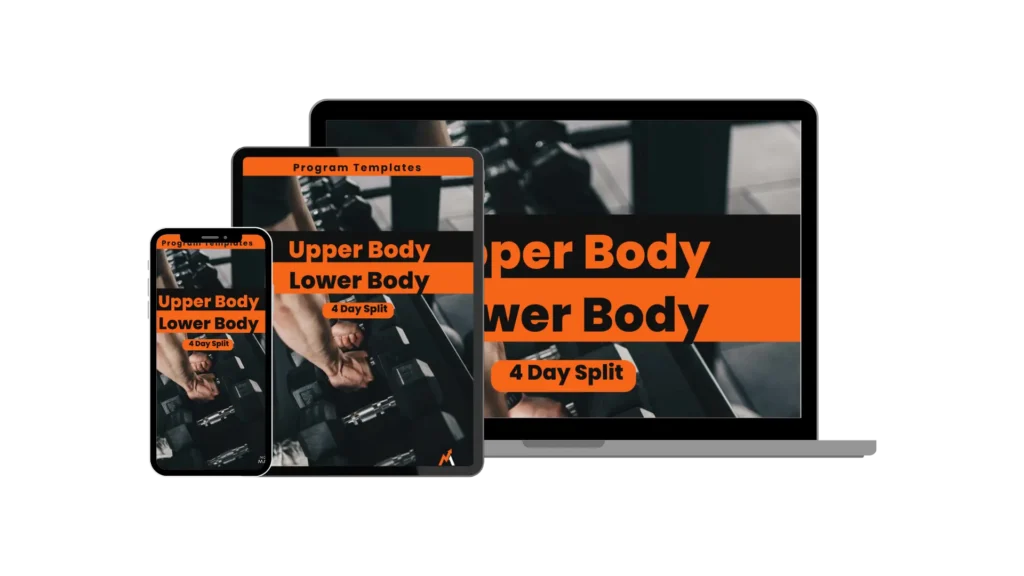The upper lower body split
what is the upper lower body split?
The upper lower body split is a popular training split that divides training days into working the upper body muscles and lower body muscles. On upper body days, you will train the chest, shoulders, back, biceps, and triceps. On lower body days you will train the leg muscles, such as the quadriceps, hamstrings, glutes, calves, as well as the lower back. Ab work can be trained on either day.
how to run the upper lower body split
The upper lower split is typically run 4 days per week, with 2 days dedicated to upper body training and 2 days dedicated to lower body training, although it can also be run 5 or even 6 times per week. The default 4 days per week setup provides a twice-per-week training frequency for each muscle group.
Here are two commonly used upper lower body split setups:
| Monday | Upper Body |
| Tuesday | Lower Body |
| Wednesday | Rest |
| Thursday | Upper Body |
| Friday | Lower Body |
| Saturday | Rest |
| Sunday | Rest |
| Monday | Upper Body |
| Tuesday | Lower Body |
| Wednesday | Rest |
| Thursday | Upper Body |
| Friday | Rest |
| Saturday | Lower Body |
| Sunday | Rest |
Lower body days are usually performed after upper body days to allow for a rest day after training legs, which is usually more stressful and requires more recovery. However, this order can be swapped around depending on what an individual is prioritizing, their goals, and personal preferences.
is the upper lower body split effective at building muscle?
The upper lower split can be used to build muscle (hypertrophy) or strength. A power-building approach can also be used, performing some exercises in a lower rep range and some in a higher rep range, if your goal is to build strength and muscle. The upper lower body split can also be used in a fat-loss phase to maintain muscle or even build muscle in certain situations.
As with any training split, there are pros and cons to the upper lower body split, and it may be more or less appropriate depending on an individual’s level of advancement, goals, age, and current lifestyle.
What Are the Pros of the Upper Lower Body Split?

Simplicity and flexibility
The upper lower body split is a simple split to run which is great for beginners. As the upper and lower body are trained on separate days there is no potential for overlap between different muscle groups which could impair recovery. This is great for beginners and early intermediate lifters who may not have the experience or knowledge to understand how to program effectively.
The upper lower body split is also flexible. If you are unable to train on your planned day you can simply perform that training session the following day. Whatever session you perform, there will be no overlap with the muscle groups you trained the previous day or might train the next day.
Maximises set quality And Intensity
One benefit of the upper lower body split is that it automatically maximises set quality when set up correctly. On upper body days, we can perform a push movement for several sets followed by a pull movement for several sets. For example, we could perform 2-3 sets of the barbell bench press, followed by 2-3 sets of a barbell row. We could then move on to our second push exercise for the day followed by our second pull exercise for the day.
The benefit of this is that the chest, shoulders, and triceps have had a longer rest period between the first and second push movements of the day, as we trained a pull movement in between. This usually results in more reps being performed on the second movement and therefore more volume, compared to if we had done back-to-back pushing movements. The same will be true for our pulling movements.
you can use antagonist-paired supersets
Another benefit of the upper lower body split is that we have the option of using antagonist-paired supersets on our upper-body days. This is where we perform a set for one muscle group followed by a set for another muscle group that performs the opposite action. An example of this would be a pushing movement such as a dumbbell chest press followed by a pulling movement such as a dumbbell chest supported row.
The benefit of this is that we can get a lot of work done in a shorter amount of time. We can train a muscle group while another muscle group is recovering between sets, instead of waiting for 2-3 minutes between sets of the same muscle group.
We do not recommend going into the antagonist set straight after a set. Instead, we prefer to wait 45-90 seconds between sets to ensure the following antagonistic sets are of the highest quality. By the time you get back to the same muscle group, 3 or more minutes may have passed which is a great way to ensure you are fully recovered and can perform a high-quality working set.
effective training frequency
The upper lower body split provides an effective training frequency of twice per week for each muscle group. This is the sweet spot for the majority of people allowing for adequate weekly volume, and ensuring high-quality sets can be performed. Performing sets at the correct intensity will maximise the stimulus for muscle growth. Twice-per-week training frequency has also been shown in research to be effective at building muscle.
Adequate recovery between sessions
As we are training the upper body and lower body only twice per week individual muscle groups will have 2 or 3 days of rest between sessions providing ample recovery, and there is no risk for overlap between different muscle groups. Training 4 X per week also allows for adequate recovery in general, as we have 3 rest days per week.
in session flexibility
When training in busy public gyms it is not always possible to perform a training session in the order you have planned. Sometimes using methods such as antagonist-paired super sets or even alternating movement patterns as mentioned previously is simply not possible. Luckily the upper lower body split has some flexibility built-in.
We can simply choose which movements to perform depending on the availability of gym equipment. Some days you may have to train back first, while on other days you may have to train chest first. If you have to perform all your push or pull movements back to back this is not a problem. You may lose a few reps here and there, however, over time it will make little difference to your results.
Training major muscle groups first is not a set-in-stone rule, and it is also possible to train smaller isolation movements first. This can even be beneficial, for example, if your priority is growing your biceps, it can be a great idea to train them first when they are fresh and you have more focus. Smaller muscle groups such as the medial delts can also be trained first, and it will not affect pushing movements later in the session as the triceps are not involved in movements such as lateral raises.
Training frequency can be easily adjusted
A training frequency of twice per week per muscle group is effective and is the sweet spot for most people, however, the upper lower body split can easily be adjusted to a higher training frequency, working the major muscle groups 3 times per week. This can be effective for certain individuals and certain situations. We can also reduce the training frequency to once every 4-5 days, depending on how we set things up.
what are the cons of the upper lower body split?
No training split is perfect and there are a few disadvantages to running an upper lower body training split.
Upper body days can be long
As we are training all the major muscle groups of the upper body in one session, upper body days can be a little long on the upper lower body training split. This will largely depend on the amount of volume you are performing over the week, so this may not be so much of a concern for beginners or early intermediate lifters. Using a modified upper-lower body split can be a potential solution to this.
advanced lifters may struggle to perform adequate volume
More advanced lifters may need to perform more volume and could struggle to fit in enough high-quality sets on their upper body days. This is likely only a problem when performing the upper lower body split 4 times per week. Adding another upper body day in the week could be a good option here.
smaller muscle groups may receive less attention
In the default setup for the upper lower body split smaller muscle groups such as the biceps, triceps, and medial and rear delts are usually placed at the end of the workout after the main compound lifts have been performed. This will naturally result in these muscle groups being trained in a more fatigued state, so set quality will not be as high as if they were trained towards the beginning of a training session or on a separate day such as in a body part split.
Toward the end of a training session, mental focus will likely also be lower, and these isolation exercises can sometimes be performed with less intensity, depending on the individual and how hard they are able to push themselves. These exercises can often be skipped altogether. Over time this can result in underdeveloped arms compared to the rest of the upper body.
One possible solution to this is changing the order of exercises. Lagging or priority muscle groups can be trained before compound exercises if set up correctly. A modified upper lower body split can also be used as mentioned previously.
alternative upper lower body split setups

We can use the upper lower body split to train more or less times throughout the week, and also increase or decrease the frequency we train each muscle group.
3 X Per Week alternating
| Monday | Upper | Lower |
| Tueday | Rest | Rest |
| Wednesday | Lower | Upper |
| Thursday | Rest | Rest |
| Friday | Upper | Lower |
| Saturday | Rest | Rest |
| Sunday | Rest | Rest |
5 Times Per Week (Arm Day)
| Monday | Upper |
| Tuesday | Lower |
| Wednesday | Rest |
| Thursday | Upper |
| Friday | Lower |
| Saturday | Arm Day |
| Sunday | Rest |
5 X Per Week (weekends off)
| Monday | Upper |
| Tuesday | Lower |
| Wednesday | Upper |
| Thursday | Lower |
| Friday | Upper |
| Saturday | Rest |
| Sunday | Rest |
3 X Per Week Alternating
If you would like a more minimalistic training split you can perform the upper lower body split three times per week on a rotating schedule. On week 1 you would train the upper body on Monday and Friday with the lower body being trained on Wednesday. The following week you train on Monday again however this time you start the week with lower body. The following week would be back to the same schedule as week 1.
This is a slightly lower training frequency than twice per week and will have you hitting a muscle group once every 4-5 days. This can be a good option to use if you are limited in time, or you are older and fairly strong and need more time to recover between sessions.
5 X Per Week With Arm/Shoulder Day
Adding an extra upper body day to the week is a great option if you need to perform more volume or would like to keep your upper body sessions a little shorter. In our example, we would make this session a little easier/lighter since we only have one day to recover before we train the upper body again on Monday.
You could also make this day more of an arm day or shoulder day (or both), to get in some extra volume throughout the week, allowing you to perform less on your other upper body days. Here you would be training the upper body at a 3 times per week frequency and the lower body at a twice-per-week frequency.
Arm day could consist of purely isolation movements, or you could include some compound movements that emphasize the arms a little more, such as triceps when performing a close grip barbell bench press. This will also allow you to get some extra chest volume. Extra work for muscle groups that can recover quickly and can often handle more volume can also be performed such as work for the upper back.
5 X Per Week With Back To Back Rest Days
If you would like to perform an extra upper body day and still have back-to-back rest days such as at the weekends you can set up the upper lower body split so that your upper body workouts are on Monday, Wednesday, and Friday, and your lower body workouts are on Tuesday and Thursday.
This is not always the best for everyone, and some experimentation may be needed. This is because we are only getting one day of rest between upper body training sessions in this setup, so more intelligent programming will likely be required.
Another potential issue with this setup is that you are only getting a day’s rest between lower body training sessions, and this could impact recovery. Managing rep ranges and intensity on your lower body days would be important in this setup. If you are fairly strong, we would recommend emphasizing muscles of the posterior chain, such as the hamstrings and glutes in one session, and making the other lower body session a more quad-focused day.
6 X Days Per Week
The upper lower body split can be run 6 times per week in certain situations, however, we find most people will not want to train their legs three times per week, which does not usually deliver any extra benefits compared to training legs twice per week, especially long term. This higher frequency approach could be used for a shorter period, in the right context, if set up correctly.
Do we recommend the upper lower body split?
The upper lower body split is a great training split and it may be the best split for a lot of people. Some of its main advantages are effective training frequency with adequate recovery between sessions, as well as its simplicity and flexibility. We recommend you start with the standard 4-day per week setup, with 2 upper body workouts and 2 lower body workouts. The upper lower split may be best suited to beginners and intermediate lifters, although more advanced lifters can add an extra upper body day and/or use a modified upper lower body split.



